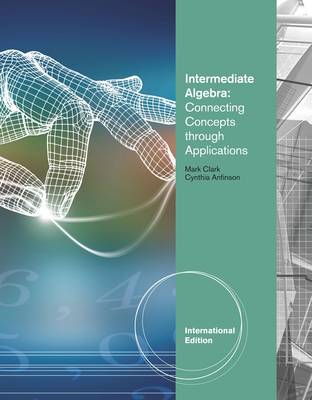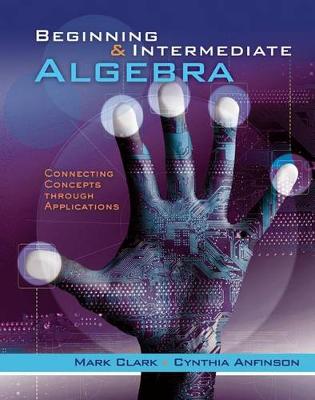Cengage Advantage Books
3 total works
INTERMEDIATE ALGEBRA: CONNECTING CONCEPTS THROUGH APPLICATIONS, International Edition shows students how to apply traditional mathematical skills in real-world contexts. The emphasis on skill building and applications engages students as they master concepts, problem solving, and communication skills. It modifies the rule of four, integrating algebraic techniques, graphing, the use of data in tables, and writing sentences to communicate solutions to application problems. The authors have developed several key ideas to make concepts real and vivid for students. First, the authors integrate applications, drawing on real-world data to show students why they need to know and how to apply math. The applications help students develop the skills needed to explain the meaning of answers in the context of the application. Second, they emphasize strong algebra skills. These skills support the applications and enhance student comprehension. Third, the authors use an eyeball best-fit approach to modeling. Doing models by hand helps students focus on the characteristics of each function type. Fourth, the text underscores the importance of graphs and graphing.
Students learn graphing by hand, while the graphing calculator is used to display real-life data problems. In short, INTERMEDIATE ALGEBRA: CONNECTING CONCEPTS THROUGH APPLICATIONS, International Edition takes an application-driven approach to algebra, using appropriate calculator technology as students master algebraic concepts and skills.
Students learn graphing by hand, while the graphing calculator is used to display real-life data problems. In short, INTERMEDIATE ALGEBRA: CONNECTING CONCEPTS THROUGH APPLICATIONS, International Edition takes an application-driven approach to algebra, using appropriate calculator technology as students master algebraic concepts and skills.
BEGINNING AND INTERMEDIATE ALGEBRA: CONNECTING CONCEPTS THROUGH APPLICATIONS, shows students how to apply traditional mathematical skills in real-world contexts. The emphasis on skill building and applications engages students as they master algebraic concepts, problem solving, and communication skills. Students develop sound mathematical skills by learning how to solve problems generated from realistic applications, instead of learning techniques without conceptual understanding.
Authors Mark Clark and Cynthia Anfinson have developed several key ideas to make concepts real and vivid for students.
First, the authors place an emphasis on developing strong algebra skills that support the applications, enhancing student comprehension and developing their problem solving abilities.
Second, applications are integrated throughout, drawing on realistic and numerically appropriate data to show students how to apply math and to understand why they need to know it. These applications require students to think critically and develop the skills needed to explain and think about the meaning of their answers.
Third, important concepts are developed as students progress through the course and overlapping elementary and intermediate content in kept to a minimum. Chapter 8 sets the stage for the intermediate material where students explore the "eyeball best-fit" approach to modeling and understand the importance of graphs and graphing including graphing by hand.
Fourth, Mark and Cynthia's approach prepares students for a range of courses including college algebra and statistics.
In short, BEGINNING AND INTERMEDIATE ALGEBRA: CONNECTING CONCEPTS THROUGH APPLICATIONS develops strong mathematical skills using an engaging, application-driven and problem solving-focused approach to algebra.
Authors Mark Clark and Cynthia Anfinson have developed several key ideas to make concepts real and vivid for students.
First, the authors place an emphasis on developing strong algebra skills that support the applications, enhancing student comprehension and developing their problem solving abilities.
Second, applications are integrated throughout, drawing on realistic and numerically appropriate data to show students how to apply math and to understand why they need to know it. These applications require students to think critically and develop the skills needed to explain and think about the meaning of their answers.
Third, important concepts are developed as students progress through the course and overlapping elementary and intermediate content in kept to a minimum. Chapter 8 sets the stage for the intermediate material where students explore the "eyeball best-fit" approach to modeling and understand the importance of graphs and graphing including graphing by hand.
Fourth, Mark and Cynthia's approach prepares students for a range of courses including college algebra and statistics.
In short, BEGINNING AND INTERMEDIATE ALGEBRA: CONNECTING CONCEPTS THROUGH APPLICATIONS develops strong mathematical skills using an engaging, application-driven and problem solving-focused approach to algebra.
BEGINNING ALGEBRA: CONNECTING CONCEPTS THROUGH APPLICATIONS shows students how to apply traditional mathematical skills in real-world contexts. The emphasis on skill building and applications engages students as they master algebraic concepts, problem solving, and communication skills. Students learn how to solve problems generated from realistic applications, instead of learning techniques without conceptual understanding. The authors have developed several key ideas to make concepts real and vivid for students. First, they emphasize strong algebra skills. These skills support the applications and enhance student comprehension. Second, the authors integrate applications, drawing on realistic data to show students why they need to know and how to apply math. The applications help students develop the skills needed to explain the meaning of answers in the context of the application. Third, the authors develop key concepts as students progress through the course. For example, the distributive property is introduced in real numbers, covered when students are learning how to multiply a polynomial by a constant, and finally when students learn how to multiply a polynomial by a monomial. These concepts are reinforced through applications in the text. Last, the authors' approach prepares students for intermediate algebra by including an introduction to material such as functions and interval notation as well as the last chapter that covers linear and quadratic modeling.


